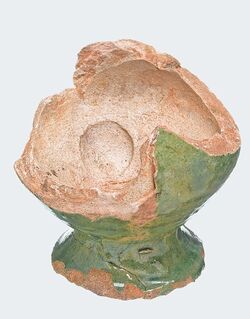Music in Shakespeare’s theatre[edit]
In Elizabethan theatre, music, and the sounds made by musical instruments, were used in a highly codified way as part of the story-telling, taking advantage of the audience’s familiarity with the richly aural culture of the time.
In the late 16th and early 17th centuries, at the Globe theatre in London (Q7846), performance days were indicated visually, by flying a flag on the roof to draw audience members across the river Thames to the theatre. However, unlike the modern visual cue of lowering the houselights, the start of the performance itself was signalled aurally, by a trumpeter placed high in the tiring tower, over the stage. To the Elizabethan listener, the sound of a trumpet fanfare was more than a simple alert. It was associated with Royal proclamations, coronations, and similar events – a sign that something momentous and authoritative was about to happen.
After that opening fanfare, music and the sounds of musical instruments were a frequent element of the performance. In Shakespeare’s history plays, the action often starts with fanfares or drums, signalling the entrance of the main, usually Royal, characters. The comedies rarely begin with sound. This sonic ‘scene setting’ continued: bells signalled either the time (representing a clock bell), or alarm or ceremony (as with a public bell such as that in a church). The sounding of horns indicated hunting, while thunder would be created symbolically with drums, or more representationally with a cannon ball rolled around the wooden floor of the tiring house. The underside of the floor of the tiring house, which formed a ceiling over the stage, was painted with the signs of the zodiac to signify the firmament. The thunder therefore came literally and symbolically from the heavens.
Modern-day archaeologists have found a ‘bird whistle’ at the site of London's Curtain Theatre, one of Shakespeare's least-historically documented playhouses (Q9336). The remains of the Curtain, which opened in 1577, were found as part of regeneration works in 2011. The Curtain was home to Shakespeare’s Company, the Lord Chamberlain’s Men, from 1597 until The Globe opened two years later. In Romeo and Juliet, first staged at the Curtain Theatre, there are numerous references to bird song such as ‘That birds would sing and think it were not night’, so although bird whistles were children’s toys, they may have been used for sound effects in theatrical performances.
In addition to the use of musical instruments for effects and punctuating sounds, the plays incorporated music and songs. Composers were commissioned to write specifically to accompany the plays. The composer Robert Johnson (Q30565) wrote music for productions by the King’s Men theatrical company between 1610 and 1617 for plays by Shakespeare and other playwrights such as Ben Jonson, Francis Beaumont and John Fletcher. Johnson composed ‘Full Fathom Five’ and ‘Where the Bee Sucks’ for the first performance of Shakespeare’s The Tempest. For winter performances at the indoors Blackfriars theatre, Johnson composed musical interludes to be played between the acts, while the candles were being replaced. Elizabethan performances generally ran continuously, without breaks, but the requirement for music to fill an interlude while a technical requirement (changing candles, setting scenery) is completed has continued until today. Modern productions of Shakespeare’s plays now sometimes commission well-known music artists to create new music or settings of the original songs.
Music was a well-established part of Elizabethan life, and people would have been familiar with music in churches (including the singing of minstrels) and at the royal court. Actors were often also trained musicians. The use of specific instruments was highly coded: percussive sounds represented war and elemental chaos, such as storms, waves and earthquakes. Brass instruments were associated with human intervention, while stringed lyrical instruments signified a peaceful idyll, the resolution of a problem or conflict, or the sweet release of death. Audiences would therefore have understood the significance of the choice of instrument, creating the opportunity to make use of the ‘wrong’ instrument for ironic or comedic effect.
In Elizabethan theatre, sound effects and music were written into the play texts as stage directions, indicating music, songs, flourishes of trumpets, and effects. A description of sound effects is provided in A Dictionary of Stage Directions in English Drama 1580-1642 (Q30566), which includes everything from simple effects to specific needs for battle scenes. These sounds were used to create atmosphere, to reproduce pistols, clocks, horses, fanfares, or alarms, but sound was also being used for symbolic effect of the supernatural and to help create drama. To the audience of the time, these sounds and music would have been highly meaningful, drawing as they did on the rich aural culture of the period.

